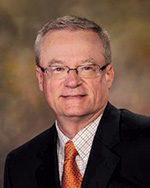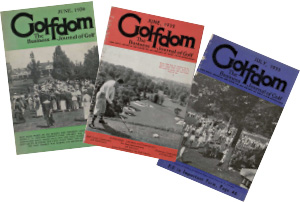Golfdom Conversation: James Hansen’s exclusive excerpt of new Robert Trent Jones biography
Golfdom chats up James Hansen, author of the new Robert Trent Jones biography “A Difficult Par,” to discuss the book and share an exclusive excerpt.
Historian James Hansen, Ph.D., may be best known for his many books about space (his biography “First Man: The Life of Neil A. Armstrong” made the New York Times’ bestsellers list) but before he could go to the moon, he had to mow around the trees.
“I got my start on a golf course. I was mowing grass at a public course in Fort Wayne, Ind., as an 11-year-old,” says Hansen, a 6-handicapper. “They told me to mow around the base of every tree, and once I finished, start over.”
His new book, “A Difficult Par: Robert Trent Jones Sr. and the Making of Modern Golf,” is a thorough, vivid and revealing 480-page epic on the game he loves. Available May 13th, 2014, the book is the result of exhaustive research and interviews, including unique access to RTJ’s personal collection of papers (350 file cabinets), drawings (literally hundreds) and, proudly, a run of Golfdom magazines dating back to the 1930s.
“A lot of people want to give back to the game of golf because it has given so much to them,” Hansen says. “To me, this was an extraordinary opportunity for me to give something back to golf that maybe it wouldn’t have had any other way, because of my training as a historian and a biographer.”
We sat down with Hansen to discuss his book, Golfdom’s impact on Jones’ career and why RTJ was the best choice for a biography.
Golfdom: Jim, congratulations on a really fascinating book on not just RTJ, but the history of American golf. To get started, let’s talk about RTJ’s early and regular involvement with the maintenance side of the game. There was some superintendent in his blood, wasn’t there?
James Hansen, Ph.D.: Even as a boy, Jones had experience in groundskeeping. He caddied, but there was a little neighborhood course called Hillcrest — Jones got a job as a young teenager mowing the grass there with a friend. So he had experience at a very early age.
Then when he got the arrangement to attend Cornell (despite having dropped out of high school), he knew that he needed classes in agronomy and soil sciences. I imagine it was pretty rare in the 1920s to have anyone designing courses with any type of formal college education that dealt with soil science.
Some of the first money he really makes in the Depression, when there weren’t ways for municipalities to pay for an architects’ fee, Jones made special arrangements to sell the grass. He made his first money from a turfgrass farm.
Golfdom: Jim, what got you and I talking in the first place is the many appearances Golfdom magazine and its founders, Herb and Joe Graffis, get in your book. How often did you find yourself scouring through an old issue of this magazine? Were you on the online archive, or did you have access to print copies?
Hansen: Fortunately, Jones kept most of his back issues of Golfdom, I didn’t have to go to a special collection. Of course, when you come across something like that and you’re a historian, you tend to start reading it. I did that with Golfdom. I’d look for the Jones advertisements.
Golfdom: That’s really cool that RTJ saved those old issues of the magazine. How important was RTJ’s relationship with (Golfdom founders) the Graffis brothers (Herb and Joe) to his early career?
Hansen: His communication with the Graffis brothers really opened the window on golf and what was going on in other parts of the country, especially in the Midwest. Jones was a regular advertiser and a regular letter writer with the Graffis brothers, and in turn, they sort of scratched each other’s backs. Jones was giving them information, sharing stories, and actually writing some stories for the magazine in the 1930s.
In exchange, the Graffis’ were sharing news of courses being built. Jones’ first course in the Midwest was a connection the Graffis’ gave him. The relationship with Jones and the Graffis brothers was very important to Jones, especially early in his career.
I don’t know — it’d be interesting to learn — if the Graffis brothers took advantage of any investment opportunities that Jones may have told them about. It’s very possible, given how entrepreneurial Jones was. I don’t know how well off Herb or Joe were, how much money they actually made doing Golfdom.
Golfdom: I don’t know the answer to that either. The thing I always hear about Herb is that he had a great sense of humor. Based on some of the jokes I’ve made in this magazine, that tradition is now long dead… So why was RTJ the character whom you chose as the focus of your first golf biography?
Hansen: I suspected that one could tell the whole story of American golf in the 20th Century by looking at Jones’ career. It spans 70 years, Coolidge to Clinton! And so many important characters — Ouimet, Sarazen, Sneed, Hogan, and into the modern era. It’s an epic story. I’m convinced there’s not another biography about a golf person that can tell you as much about the history of golf as RTJ.
Golfdom: Jim, thanks so much for taking the time to chat with us and for providing our readers this free sneak preview of the book. I look forward to seeing how your book is received once it’s released.
Hansen: I’m anxious too! Thank you, Seth, I appreciate it.
From Chapter 4: “Parting Company”
The widow of the late Alister MacKenzie, Hilda MacKenzie, had recently written to him about a book manuscript on golf architecture that her husband had left unpublished. She was asking Jones to collaborate on the book, as her husband regarded the architectural principles of Thompson-Jones as quite similar to his own. “I am expecting her official approval in a week or two,” Robert told Stanley, “and would go to work on it at once.”
Once again, the truth was a little different than what Jones had related to Thompson. Jones had learned about the MacKenzie manuscript a full ten months earlier, upon reading Herb Graffis’s mention of it in Golfdom’s February 1934 tribute to MacKenzie on his passing. Robert had never spent a great deal of time with MacKenzie, nor personally seen any of his other courses, but in early May 1932 he enjoyed a round of golf with him on the day prior to the official opening of MacKenzie’s new Bayside course, on the northwestern end of Long Island. Along with MacKenzie, Jones had played that day with Innis Brown, who with Grantland Rice was co-editor of The American Golfer, the leading golf magazine of its time.
Robert quickly made it known to Graffis that he was interested in taking charge of the MacKenzie manuscript and also in being the chief writer for Golfdom’s new architectural department — a spot that Graffis had discussed with MacKenzie. Making inquiries around New York City, Jones found that Scribner’s, the publisher initially interested in the doctor’s book, had decided that the market for the book was too small to merit publication. That discovery prompted Jones, in mid-October 1934, to write again to Graffis:
The thought came to me that perhaps by combining the Doctor’s ideas and our own the book might still be published. If so, it could be a fine and fitting tribute to the late Doctor and his work. If the idea were feasible, Mrs. MacKenzie’s consent would be needed. Any material that the Doctor had written, and photographs of his work, could be sent to me. If the book were published and any remuneration were forthcoming, I would be willing that Mrs. MacKenzie receive the lion’s share.
Graffis informed Jones that Hilda MacKenzie had returned to England with her son Tony Haddock but could be reached in care of Leeds College of Music, Cavendish Road, in Leeds, where Tony taught. Jones initiated a correspondence with Mrs. MacKenzie, asking if she would consent to allow him to get her husband’s book published. Though no letter from Hilda MacKenzie seems to exist in Jones’s papers, she apparently gave him the go-ahead, because Jones, after getting a copy of the manuscript from Graffis (and apparently later another one from Hilda), began to shop it around. Robert kept Graffis updated on his efforts. (Upon receipt of the manuscript from Graffis, Jones had replied: “I have just gleaned over it and received the same kick that I always do when I glimpse the doctor’s art. He certainly was a genius.”) An editor at McGraw-Hill showed interest, but the publisher wanted the help of a large subsidy or a guaranteed advance sale of books, neither of which Jones could arrange, although he tried. In late November 1936 he wrote to Dixwell Davenport, a member of the USGA Green Section and chairman of the greens committee at San Francisco Golf Club (a Tillinghast design from circa 1921):
I plan to bring out a new book in the Spring through the McGraw Hill Publishing Company, which will discuss the modern theories on trapping and green design. Part of this volume is an unfinished manuscript by the late Dr. MacKenzie. His widow sent it on to me for completion, stating that her late husband considered our work most similar to his in strategy and beauty.
Not long after that, McGraw-Hill told Robert there was no deal. Preoccupied with a number of new design jobs, he stowed away his copy of the MacKenzie manuscript in his files, where it remains to this day in the Jones Papers at Cornell.
Dr. MacKenzie’s book, entitled The Spirit of St. Andrews, was eventually published, but not until 1995, after a copy of the manuscript was reportedly found by Raymond M. Haddock among the papers of his late father, Tony Haddock, MacKenzie’s stepson. Believing there was no other copy, Sleeping Bear Press, the publisher, stamped the book with the label “The Lost Manuscript” and advertised it as “golf’s equivalent to the Dead Sea Scrolls.” The book became an instant classic and a must-have for every golf library. The book’s acknowledgments made no mention of Robert Trent Jones’s recognition of the book’s worth back in 1935 and his efforts to get it published sixty years earlier. (Robert Trent Jones Jr. believes that it was his father’s copy of the MacKenzie manuscript, which had been marked as “typed by Ione” — typed by her back in the mid-1930s from MacKenzie’s handwritten manuscript — that somehow found its way from his father’s office papers into the hands of Haddock and from there to Sleeping Bear Press.)
Reprinted by arrangement with GOTHAM BOOKS, a member of Penguin Group (USA) LLC, A Penguin Random House Company.
Copyright © JAMES R. HANSEN, 2014.













